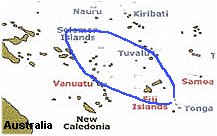Active volcanoes / Aktive vulkaner:
Metis Shoal, Tonga, Pacific Ocean
|
Submarine eruption breaks the surface on 12 December 1967, building new island January 2nd, 1968: Ship reported sighting eruption at 3 a.m. on 12 December 1967. Undersea volcanic eruption building itself above the surface. By January 6th, island had built itself to be 150 feet high and one mile long January and February 1968: Violent eruption throwing lava 1,000 feet into the air with steam and smoke billowing to 4,000 feet and higher. Island is half a mile wide and 100 feet high. Activity decreases and island erodes below ocean surface by late February 1968 Spectacular smoke cloud billowing thousands of feet in the air. Steady formation of new island as hundreds of tons of rock are thrown 400-500 feet in the air. Report made from aircraft chartered by the King of Tonga. May and June 1979. Large areas of pumice sighted between the Tonga and Fiji islands New island grows to 15 m high in mid-July 1979 Geologists aboard the R.V. Bulikula inspected the volcanoes along the Tonga Arc between 3 and 21 July. A new island, named Late Iki, had formed above Metis Shoal at 19.18°S, 174.85°W, site of strong activity in June. The new island, comprised of tephra ranging in size from ash to large bombs, was ~300 m long, 120 m wide, and 15 m high in mid-July. Emission of hot ash continued from the E end of the island. Fumarolic activity on the island during August, 1979, pumice washes ashore 1,150 km NW away October 1979, Pumice sighted in Solomons and New Hebrides
Floating pumice, presumably from the recent island-forming eruption of Metis Shoal was reported at two widely separated locations during October. On 6 October, Samuel Iko, aboard the M.V. Independence, observed a blanket of pumice floating between the islands of Guadalcanal, the Florida Group, and Malaita (Solomon Islands), with the greatest concentration at about 9.5°S, 160.5°E, approximately 3,000 km WNW of Metis Shoal. Other reports indicated that pumice washed ashore at Marau, an islet at 8.5°S, 159.5°E, as the raft moved southward through the Solomons. On 25 October, John Carney sighted dark friable pumice on the beach on the S coast of Efate Island, New Hebrides (17.8°S, 168.5°E), about 1,850 km W of Metis Shoal. This is the first known observation of pumice from Metis Shoal in Vanuatu, the island that formed over Metis Shoal, were made in early October. At that time, the island had nearly disappeared beneath the ocean's surface.
June 1995, Eruption builds new island An island breached the surface ~12 June, but the growth of a lava dome above sea level was first observed on 14 June. A video taken on 14 June by a local tour operator (Allan Bowe), ~400-500 m away from the new island, was widely distributed by television news organizations. The video narrator noted that the water around the boat was discolored green. Based on the video and photographs, Brad Scott estimated that the dome was ~30 m high with a diameter of 150-180 m. Ash-laden eruptions seen on the video discharged from two sources. The first was directed NW, apparently from the dome wall. The second generated stronger explosions vertically from the dome center to heights of 300-500 m. The NNE face of the dome was steaming vigorously from what appeared to be parallel vertical sources, probably fractures in the advancing flow front. The steam plume, originating from the N and S sides of the dome, was rising 500-800 m before being blown downwind for several kilometers. By 20 June the lava dome was 240 x 280 m in size (67,200 m2) and ~54 m above sea level; the next day it was an estimated 200-500 m across and 50-80 m high. The volume of the dome was estimated at ~2.8 x 106 m3, three times that on 14 June. The island, named Late Iki by the Tongan government, disappeared in October 1979
2006. Here we go again. See the picture.
|




